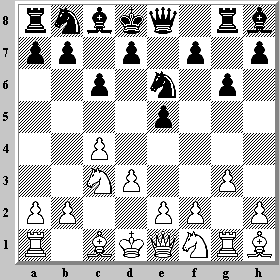The start position (SP535, RNBKQNRB) is not too far from a traditional chess game. The royalty is in the center and the Queenside pieces ('a-side' for the purists) are in their traditional places ('RNB'). Only the Kingside pieces ('h-side') are scrambled. The first four moves were 1.g3 g6 2.c4 e5 3.Nc3 Ne6 4.d3 c6, bringing the game to the following position.
8th FiNet Open, Mainz 2009
Mamedyarov, S.
Grischuk, A.
(After 4...c7-c6)
Here is an explanation, as I see it, of those first moves.
- 1.g3: Opens the diagonal for the Bh1. The move 1.g4 is an alternative, but as Grischuk explained in the interview, he's wary of the b4/g4 ideas.
- 1...g6: The same thinking as for 1.g3, from Black's point of view.
- 2.c4: Prepares the development Nb1-c3 and takes control of d5, an important central square. The move is reminiscent of the English opening in traditional chess.
- 2...e5: Prepares the development ...Nf8-e6 and takes control of d4, also an important central square. The move is reminiscent of an important counter to the English opening in traditional chess (1.c4 e5).
- 3.Nc3: Follows through the previous move and develops the Knight to its best square.
- 3...Ne6: Ditto.
- 4.d3: Prepares the development of the Bc1 on its long diagonal.
- 4...c6: Counters the influence of the White Bishop on the long diagonal and prevents a White piece from moving to d5.
So far, both players have developed their pieces in classic style by developing a Knight to a good square, opening a diagonal for a Bishop, and paying attention to the center. Now White probably considered what to do about further development. The move 5.Ne3 forces the Bishop on c1 to go eventually to d2, where it blocks the Queen from developing. The move 5.Be3 forces the Knight on f1 to go to d2, where it also blocks the Queen.
This thinking leads to the idea 5.Bh6, where White has to calculate the tactical consequences of the Bishop trap 5...g5. After these fifth moves for both players, the game continued 6.h4 gxh4 7.Be4 Bf6 8.Ne3 hxg3 9.O-O-O. White is temporarily two Pawns down, but Black is lagging badly in development on the Queenside.
Since this is a chess960 blog, and the only real difference between traditional chess and chess960 is the opening phase, I'll stop here. White has castled O-O-O, while the Black King will find shelter on c7. Here is the complete game score...
[Event "CCM9 - 8.FiNet Open"]
[Site "Mainz"]
[Date "2009.07.31"]
[Round "8.1"]
[White "Grischuk, Alexander"]
[Black "Mamedyarov, Shakhriyar"]
[Result "1-0"]
[Variant "chess 960"]
[SetUp "1"]
[FEN "rnbkqnrb/pppppppp/8/8/8/8/PPPPPPPP/RNBKQNRB w GAga - 0 1"]
[PlyCount "97"]
[EventDate "2009.??.??"]
[EventCountry "GER"]
[Source "Chess Tigers"]
[SourceDate "2009.01.01"]
1.g3 g6 2.c4 e5 3.Nc3 Ne6 4.d3 c6 5.Bh6 g5 6.h4 gxh4 7.Be4 Bf6 8.Ne3 hxg3 9.O-O-O d6 10.fxg3 Bg5 11.Rh1 Bxh6 12.Rxh6 Qf8 13.Nf5 Na6 14.Qf2 Bd7 15.Rdh1 Nac5 16.b4 Na6 17.a3 Kc7 18.Kb2 Rd8 19.Qxa7 Rb8 20.Rxh7 Ng5 21. R7h5 Bxf5 22.Bxf5 Ra8 23.Qe3 Qe7 24.Rc1 Kb8 25.g4 Nc7 26.d4 f6 27.d5 c5 28.b5 Ne8 29.Rh2 Qc7 30.Ne4 Nxe4 31.Qxe4 Qa5 32.Qe3 Ka7 33.Qc3 Qd8 34. Rch1 Ng7 35.Bc2 Ne8 36.Qf3 Qa5 37.Rh7 Kb6 38.R1h4 f5 39.Rf7 fxg4 40.Qg3 Qd2 41.Rhh7 Ra7 42.Qh4 Qd4+ 43.Kb1 Qg1+ 44.Ka2 Nc7 45.Qe7 Nxb5 46.Qxb7+ Rxb7 47.Rxb7+ Ka5 48.Rxb5+ Ka6 49.Rhb7 1-0
...courtesy of Chesstigers.de. For an explanation of the PGN specific to chess960, see my previous post Chess960 PGN.

No comments:
Post a Comment